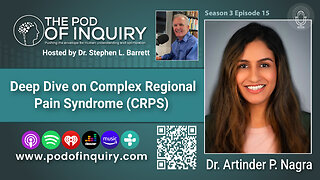Complex Regional Pain Syndrome Patient
Ron Victor was diagnosed with Complex Regional Pain Syndrome. CRPS is a chronic pain disorder that gets worse over time. Since coming to Synapse Orthopedic Group, he has been treated by Edwin Haronian MD and Jonathan Kohan MD and feels much better.
Call us to schedule an appointment: (818) 788-2400
Locations in Pomona, Sherman Oaks, and Los Angeles
Complex regional pain syndrome is an uncommon form of chronic pain that usually affects an arm or a leg. Complex regional pain syndrome typically develops after an injury, surgery, stroke or heart attack, but the pain is out of proportion to the severity of the initial injury.
The cause of complex regional pain syndrome isn't clearly understood. Treatment for complex regional pain syndrome is most effective when started early. In such cases, improvement and even remission are possible.
Signs and symptoms of complex regional pain syndrome include:
Continous burning or throbbing pain, usually in your arm, leg, hand or foot
Sensitivity to touch or cold
Swelling of the painful area
Changes in skin temperature — at times your skin may be sweaty; at other times it may be cold
Changes in skin color, which can range from white and mottled to red or blue
Changes in skin texture, which may become tender, thin or shiny in the affected area
Changes in hair and nail growth
Joint stiffness, swelling and damage
Muscle spasms, weakness and loss (atrophy)
Decreased ability to move the affected body part
Symptoms may change over time and vary from person to person. Most commonly, pain, swelling, redness, noticeable changes in temperature and hypersensitivity (particularly to cold and touch) occur first.
Over time, the affected limb can become cold and pale and undergo skin and nail changes as well as muscle spasms and tightening. Once these changes occur, the condition is often irreversible.
Complex regional pain syndrome occasionally may spread from its source to elsewhere in your body, such as the opposite limb. The pain may be worsened by emotional stress.
In some people, signs and symptoms of complex regional pain syndrome go away on their own. In others, signs and symptoms may persist for months to years. Treatment is likely to be most effective when started early in the course of the illness.
If you experience constant, severe pain that affects a limb and makes touching or moving that limb seem intolerable, see your doctor to determine the cause. It's important to treat complex regional pain syndrome early.
Complex regional pain syndrome occurs in two types, with similar signs and symptoms, but different causes:
Type 1. Also known as reflex sympathetic dystrophy syndrome, this type occurs after an illness or injury that didn't directly damage the nerves in your affected limb. About 90 percent of people with complex regional pain syndrome have type 1.
Type 2. Once referred to as causalgia, this type follows a distinct nerve injury.
Many cases of complex regional pain syndrome occur after a forceful trauma to an arm or a leg, such as a crush injury, fracture or amputation. Other major and minor traumas — such as surgery, heart attacks, infections and even sprained ankles — also can lead to complex regional pain syndrome. Emotional stress may be a precipitating factor, as well.
It's not well-understood why these injuries can trigger complex regional pain syndrome, but it may be due to a dysfunctional interaction between your central and peripheral nervous systems and inappropriate inflammatory responses.
For more information please visit our website at: http://www.synapsedoctor.com
You can also follow our social media pages at:
http://www.facebook.com/synapsedoctor
http://www.instagram.com/synapsedoctor
http://www.twitter.com/synapsedoctor
-
![Peripheral Neuropathy Causes? [Restless Leg Syndrome Treatment?]](https://hugh.cdn.rumble.cloud/s/s8/1/3/3/e/E/33eEk.0kob-small-Peripheral-Neuropathy-Cause.jpg) 0:58
0:58
Dr. Tom Biernacki
11 months ago $0.02 earnedPeripheral Neuropathy Causes? [Restless Leg Syndrome Treatment?]
116 -
 4:27
4:27
Dr. Eric Berg
11 years agoRelief with Reflex Sympathetic Dystrophy (RSD) and Complex Regional Pain Syndrome (CRPS)
15 -
 56:26
56:26
VidalSPEAKS...
5 years agoEP 119 - Dr. David Hanscom MD On Basic Family Triggers Around Pain
19 -
 8:21
8:21
Dr. Eric Berg
4 years agoMost Pain is Referred Pain – Explained By Dr. Berg
42 -
 55:48
55:48
The Pod of Inquiry - The Podcast for Podiatrists
5 months agoDeep Dive on Complex Regional Pain Syndrome (CRPS) with Artinder Nagra, DPM, FAENS
37 -
 1:13:00
1:13:00
VidalSPEAKS...
7 years agoEP 71 - Dr. David Hanscom MD — Back In Control: A Surgeon’s Roadmap Out of Chronic Pain
23 -
 1:29:26
1:29:26
Dr. Robert Morse
1 year agoDr. Morse’s Q&A –Iridology, Pain, Type 1 Diabetes and More #633
1.22K1 -
 42:59
42:59
The Wellness Way with Philly J Lay
1 year ago $0.03 earnedDr Perry Nickelston; Chasing Pain, You're Not Alone
250 -
 16:52
16:52
BobandBrad
2 years agoWhat are Common Tests for SI Pain?
57 -
 2:11
2:11
The Nerve Doctors - Neuropathy Pain Treatment
7 months agoDo I Need To Use IR Therapy For Neuropathy Forever? - Ask The Nerve Doctors
151